Bacterial Growth
1/45
There's no tags or description
Looks like no tags are added yet.
Name | Mastery | Learn | Test | Matching | Spaced |
|---|
No study sessions yet.
46 Terms
What are the 4 ways bacterial cells can divide?
binary fission (main way)
budding
parent cells
spores and hyphae
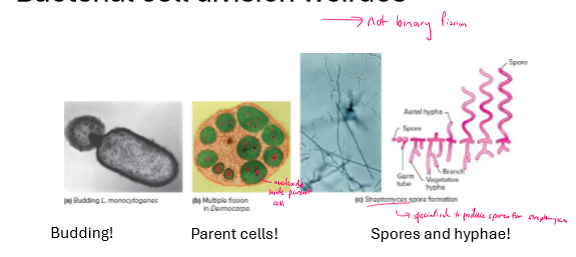
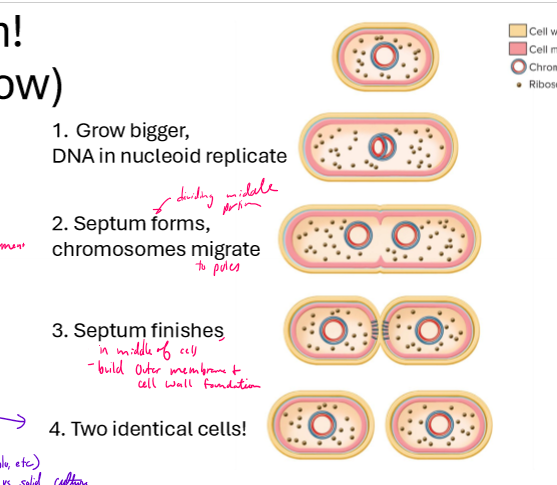
What are the 4 main steps of binary fission?
grow larger, DNA in nucleoid replicate
septum forms, chromosomes migrate to poles
septum finishes forming in middle of cells, outer membrane and cell wall foundation
two identical cells
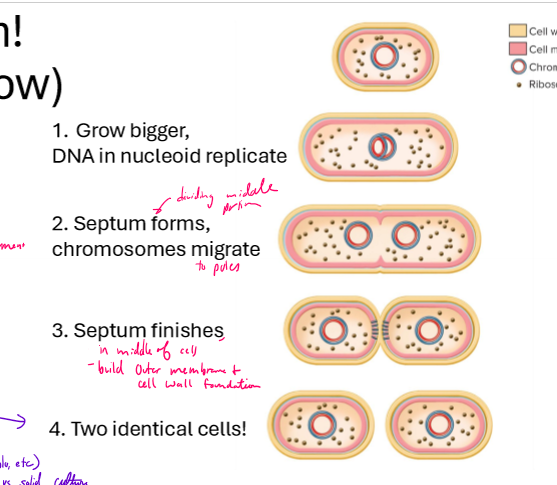
How does the arrangement of bacterial cells vary depending on what kind of media theyre grown in?
longer (strepto) in liquid, shorter in solid cultures (single, diplo)
Describe the bacterial cell cycle
Initiation mass of cell reached
Initiation of replication; Replication of chromosome by replisome proceeds from origin to terminus in both directions; cell increases in length; nucleoid obstructing septum formation
Septum formation begins when Z ring forms; chromosomes separate as septum formation continues
cells divide
What is first required before a cell begins replication?
cell large enough (initiation mass reached)
enough E
enough space
enough proteins, etc. for forming daughter cell
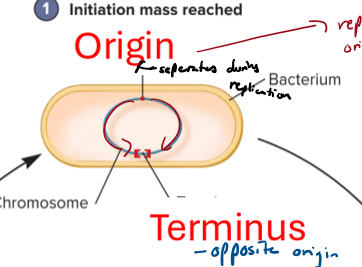
What are the origin and terminus?
origin: where chromosomal replication begins
terminus: where chromosomal replicating ends; opposite origin
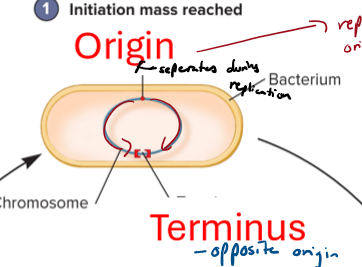
What is a replisome and what process is it in?
protein complex that copies DNA helix to form daughter chromosomes
assembles at origin
cell cycle
What is cytokinesis and what occurs during bacterial cytokinesis?
division of cytoplasm by synthesis of a septum; divison of cell during cell division
1. septum site collection (nuceloid occlusion and min system)
Assembly of Z ring (by FtsZ proteins that scaffold where the cell divides and direct peptidoglycan wall synthesis)
assembly of peptidoglycan synthesis proteins
constriction of cell and septum formation
Why does the timing and location of Z ring formation matter?
need 2 fully formed chromosomes to separate
need enough E available for 2 cells to survive
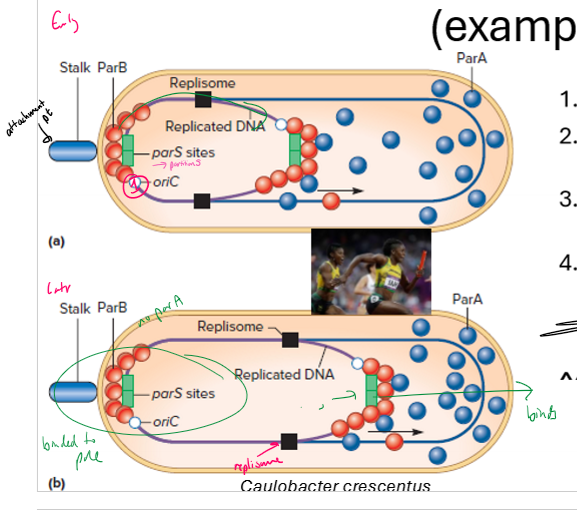
How does the partitioning system of chromosomes during cell replication work?
ParA relay
1. DNA replicates in 2 directions from origin
parS sites downstream from replication (on the chromosome) bind to parB proteins and anchors to 1 pole of cell (forms partition complex)
one partition complex anchored at stalk/pole, other guided by ParA proteins up concentration gradient to opposite pole (like handing off the other chromosome to parA after parA)

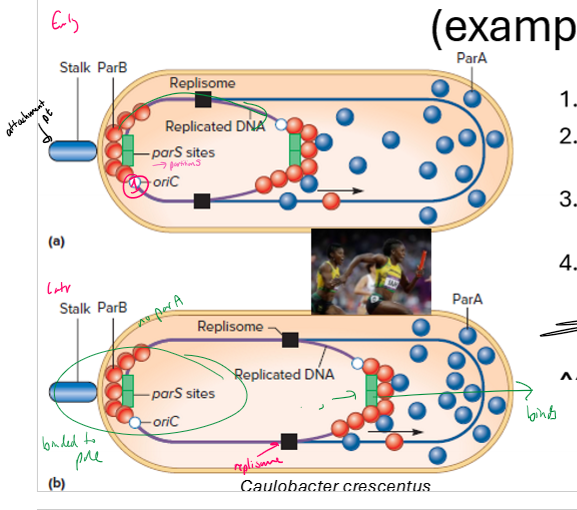
What is a partition complex?
A structure formed during bacterial cell replication that anchors replicated chromosomes at one pole of the cell, ensuring proper distribution to daughter cells
made of parS sites on chromosome binding to parA proteins


How is septum formation/ the septation site mediated?
by FtsZ (cytoskeletal protein), deposits and directs peptidoglycan synthesis by forming Z ring
Nucleoid occlusion - nucleoid in middle of cell prevents septum formation until nucleoid anchored to poles
Min system - min system proteins concentrated at poles, move back and forth between them. At high concentrations, prevents ftsZ from polymerizing and forming Z-ring. Thus, ftsZ accumulates in middle of cell
FtsZ forms Z-ring (scaffold for peptidoglycan assembly)
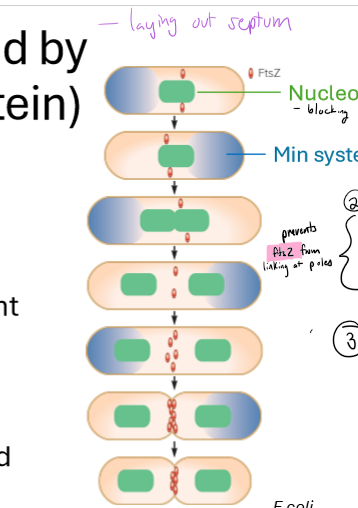
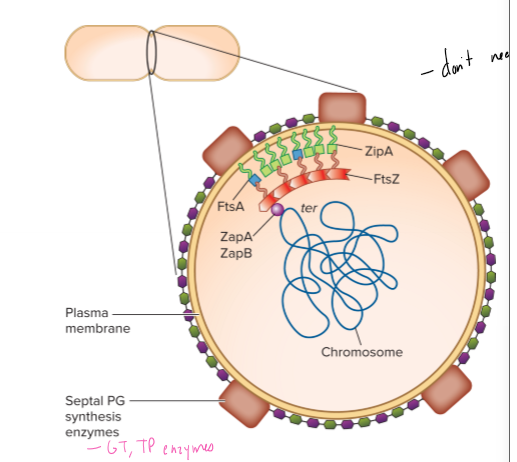
What is the Z ring?
scaffold for peptidoglycan assembly complex
initiatied by ftsZ proteins
anchors through other proteins to plasma membrane and peptidoglycan wall
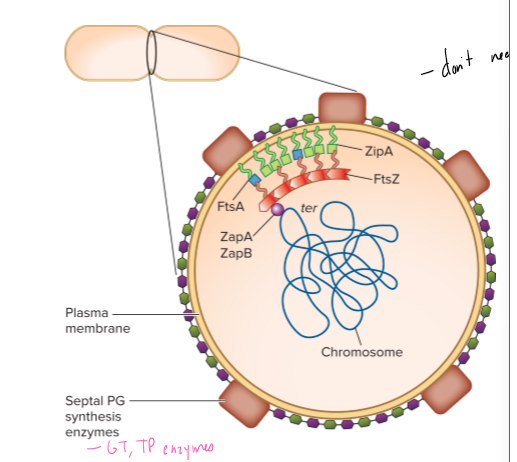
Describe the steps of peptidoglycan synthesis during cell replication
Synthesis of NAG-NAM-amino acids in cytosol; attached to bactoprenol protein carrier
bactoprenal carrier gives NAG-NAM complex to flippase protein imbedded in plasma membrane
flippase flips NAG-NAM-peptide complex to outside of plasma membrane
Peptidoglycan glycotransferase protein (GT) inserts itself into strand
Transpeptides (TP) crosslink strands
What is FtsZ?
cytoskeletal proteins that form Z ring
What are eutrophic environments?
nutrient rich environments
What are oligotrophic environments?
nutrient limited/poor (most environments)
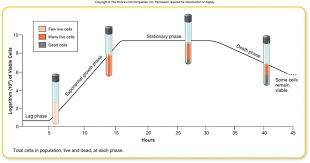
Describe the phases of the bacterial growth curve
Lag phase - no growth; cells growing, getting E, assembling parts for binary fission
Exponential phase - exponential and efficient growth
Stationary phase - no growth; birth rate = death rate
Death phase - decline; death rate>birth rate, not enough E
Long term stationary phase - up and down growth, genetic variants arise here
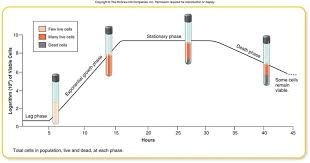
AT what stage of bacterial growth do genetic variants arise and why?
long term stationary phase
diff genetic variants can arise as bacteria adjust to suboptimal conditions
What is a generation time for bacterial cells?
amount of time at optimal growth it takes for the number of cells to double
What are the pH ranges for acidophiles, neutrophiles, and alkaliphiles?
acidophiles = 0 - 5.5
neutrophiles = 5.5 - 8
alkaliphiles = 8 - 11.5
What is the septum?
The septum is a partition that forms between dividing bacterial cells during binary fission, allowing for cell separation and growth.
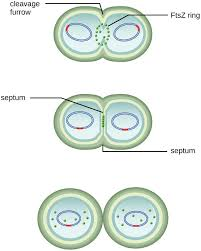
What is a halophile and under what conditions do they grow best?
thrives in high salt conditions
What is a halotolerant and under what conditions do they grow best?
can survive medi/high salt conditions but prefer low
What pH optima-suited organisms would survive best in humans?
neutrophiles
What is a mesophile and what kind of bacteria are they often?
bacteria that grow best between 25-45 degrees C
pathogens
What are the temperature optima of organisms and their ranges?
psychrophiles - 0-20
psychrotrophs - 0-35
mesophiles - 20 - 45
thermophiles - 45-85
hyperthermophiles- 80-100
For an organism to undergo aerobic respiration with O2 as the fianl electron acceptor, what must they be able to do?
must have ETC
need to be able to inactive toxic O2 intermediates/byproducts
What are the oxygen concentration optima ranges and where do they grow best?
obligate aerobe - high O2 only
microaerophile - very specific O2 required, grow only slightly below atmospheric O2
facultative anaerobe - like high O2 envs best, but can survive in all levels of O2; ex. E coli
Aerotolerant anaerobe - don’t use O2 as final e- acceptor, but aren’t killed by O2; still have some O2 dismantling enzymes; because don’t use O2 as final e- acceptor, dont’t make the most ATP
Strict anaerobe - zero O2 envs only, O2 toxic to them
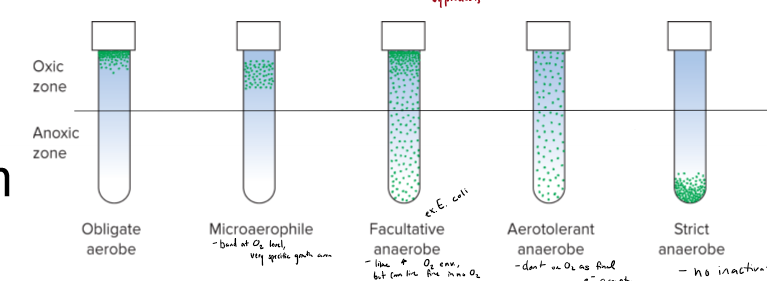

What kind of organisms would grow like this in a tube with high O2 at the top to low O2 at the bottom?
microaerophile

What kind of organisms would grow like this in a tube with high O2 at the top to low O2 at the bottom?
obligate aerobe
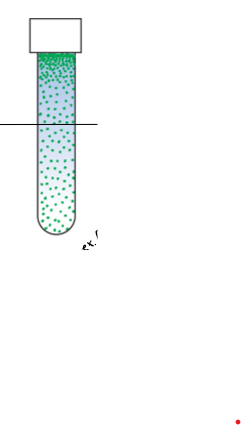
What kind of organisms would grow like this in a tube with high O2 at the top to low O2 at the bottom?
facultative anaerobe

What kind of organisms would grow like this in a tube with high O2 at the top to low O2 at the bottom?
aerotolerant anaerobe

What kind of organisms would grow like this in a tube with high O2 at the top to low O2 at the bottom?
strict anaerobe
What is growth arrest and two examples?
temporary redudciton/cessation in cell metabolism and processes
ex. viable but non culturable - short term inability to grow in conditions usual for growth
ex. persisters - able to survive antibiotics without resistance genes
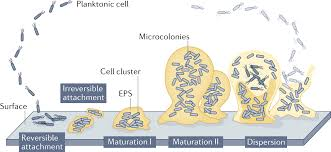
What are biofilms?
organized microbial communities encased in extracellular polymeric substances (EPS) such as adhesions, DNA, and polysaccharides to form a matrix on top of a substrate
What is a sessile bacteria?
bacteria that are part of a biofilm (most bacteria in nature)
What is a planktonic bacteria?
free living bacteria
What is an Extracellular polymeric substance (EPS)?
A slimy material produced by microorganisms, consisting of polysaccharides, proteins, and nucleic acids, that facilitates the formation and maintenance of biofilms.
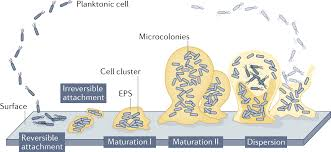
What are the functions of biofilms?
protection (UV, antibiotics, host)
adhesion to surfaces
nutrients
recolonizing/dispersing
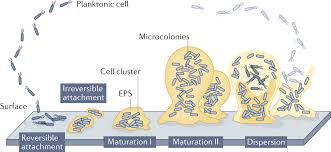
How do biofilms form?
cells deposited and attached to surface
cell-to-cell signaling via quorom sensing
replication and growth
dispersal
What is quorum sensing? Describe the steps
communication process that enables bacteria to build biofilms by detecting and responding to cell population density
autoinducer Homoserine lactone (HSL) diffuses out of cell down conc gradient
population grows
extracellular HSL increases, reverse concentration gradient and diffuses into cells
HSL binds to a receptor, triggering gene expression changes related to biofilm formation
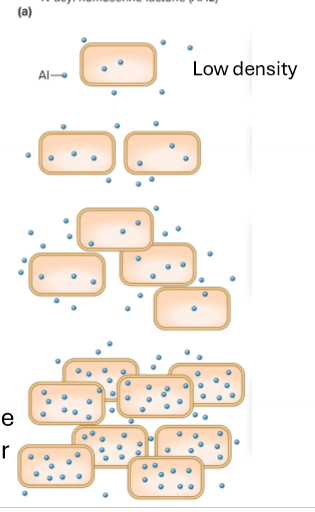
what is blood agar?
differential media
can tell apart bacteria by ability to lyse red blood cells and extract nutrients
What is a spread/pour plate?
diluted liquid sample containing microorganisms is spread evenly across the surface of a solid agar medium to create isolated, countable colonies

What is a flow cytometer (hemacytometer)?
after a liquid sample of bacteria is filtered, sample is put on plate with a grid and organisms are directly counted
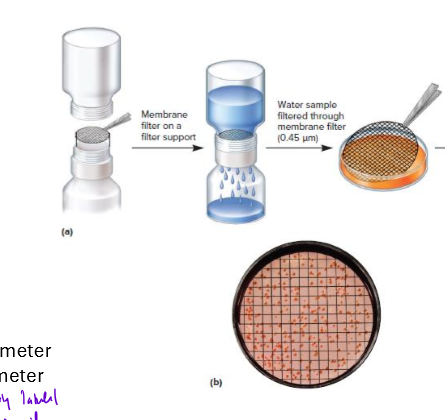
How is spectrophotometry used in microbiology? What is the con?
used to indirectly count organisms and make growth curves
High absorbance = more bacteria
can’t tell if bacteria are derad